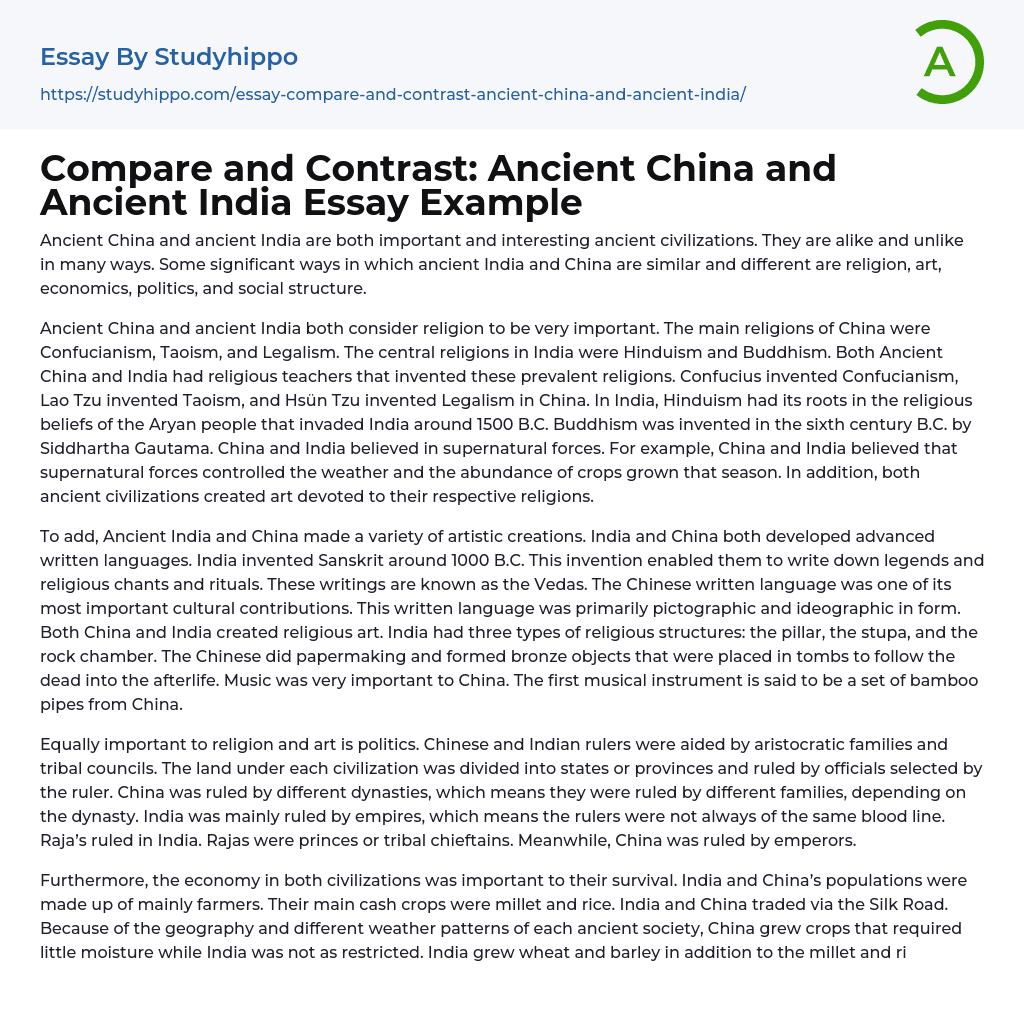

Compare and Contrast: Ancient China and Ancient India Essay Example
Ancient China and ancient India are both important and interesting ancient civilizations. They are alike and unlike in many ways. Some significant ways in which ancient India and China are similar and different are religion, art, economics, politics, and social structure.
Ancient China and ancient India both consider religion to be very important. The main religions of China were Confucianism, Taoism, and Legalism. The central religions in India were Hinduism and Buddhism. Both Ancient China and India had religious teachers that invented these prevalent religions. Confucius invented Confucianism, Lao Tzu invented Taoism, and Hsün Tzu invented Legalism in China. In India, Hinduism had its roots in the religious beliefs of the Aryan people that invaded India around 1500 B.C. Buddhism was invented in the sixth century B.C. by Siddhartha Gautama. China and India believ
...ed in supernatural forces. For example, China and India believed that supernatural forces controlled the weather and the abundance of crops grown that season. In addition, both ancient civilizations created art devoted to their respective religions.
To add, Ancient India and China made a variety of artistic creations. India and China both developed advanced written languages. India invented Sanskrit around 1000 B.C. This invention enabled them to write down legends and religious chants and rituals. These writings are known as the Vedas. The Chinese written language was one of its most important cultural contributions. This written language was primarily pictographic and ideographic in form. Both China and India created religious art. India had three types of religious structures: the pillar, the stupa, and the rock chamber. The Chinese did papermaking and formed bronze objects that were placed in
tombs to follow the dead into the afterlife. Music was very important to China. The first musical instrument is said to be a set of bamboo pipes from China.
Equally important to religion and art is politics. Chinese and Indian rulers were aided by aristocratic families and tribal councils. The land under each civilization was divided into states or provinces and ruled by officials selected by the ruler. China was ruled by different dynasties, which means they were ruled by different families, depending on the dynasty. India was mainly ruled by empires, which means the rulers were not always of the same blood line. Raja’s ruled in India. Rajas were princes or tribal chieftains. Meanwhile, China was ruled by emperors.
Furthermore, the economy in both civilizations was important to their survival. India and China’s populations were made up of mainly farmers. Their main cash crops were millet and rice. India and China traded via the Silk Road. Because of the geography and different weather patterns of each ancient society, China grew crops that required little moisture while India was not as restricted. India grew wheat and barley in addition to the millet and rice mentioned above. Ancient India and China imported and exported goods differently, too. India traded by camel caravans and by sea. China mainly traded via the Silk Road.
Ancient China and India both had social structures that basically dictated their ways of life, too. They both had patriarchal societies. This meant that their societies were dominated by men. Family was extremely important in both cultures. In addition, China and India each had their own caste system. In India, at
the top of the cast system were the priests. Then came warriors, commoners, the Sudras, and the Untouchables. The caste system in China was headed by the king and his family, the king’s aids and their families, landowners, farmers, and slaves. China also believed in filial piety. This meant that all members of a Chinese family had to subordinate their needs and desires to those of the male head of the family.
In conclusion, ancient India and China were two very important civilizations in the ancient world. They were similar in many ways. However, these civilizations were also different in many ways. These similarities and differences can be seen in their respective religions, art, economies, politics, and social structures.
- Puritans essays
- Afterlife essays
- Buddhism essays
- Christianity essays
- Deism essays
- Faith essays
- God essays
- Hinduism essays
- Islam essays
- Jews essays
- Judaism essays
- Monotheism essays
- New Testament essays
- Ritual essays
- Sin essays
- Soul essays
- Theology essays
- Confession essays
- Devil essays
- Miracle essays
- Monk essays
- Revelation essays
- Atheism essays
- Immortality essays
- Jainism essays
- Sinners essays
- Bible essays
- Old Testament essays
- Salvation essays
- Temple essays
- Taoism essays
- Pilgrimage essays
- Freedom Of Religion essays
- Existence of God essays
- Christian Worldview essays
- Cosmological Argument essays
- Gautama Buddha essays
- Karma essays
- Buddha essays
- Baptism essays
- Holy Spirit essays
- Jesus Christ essays
- Adam And Eve essays
- Crucifixion Of Jesus essays
- Crusades essays
- Eucharist essays
- God The Father essays
- Pope essays
- Protestantism essays
- Christian essays



